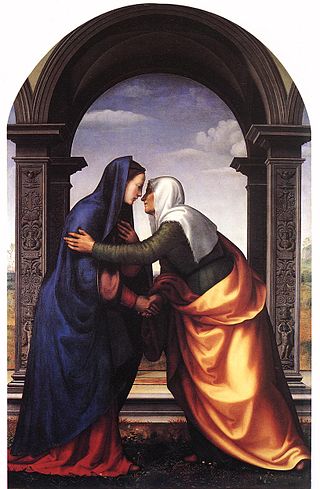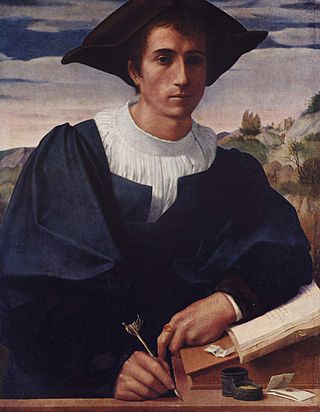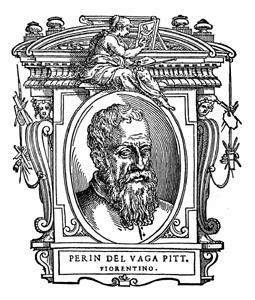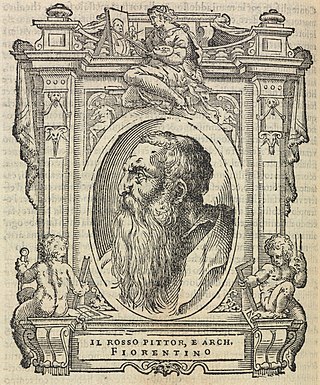Related Research Articles

Fra Bartolomeo or Bartolommeo, also known as Bartolommeo di Pagholo, Bartolommeo di San Marco, Paolo di Jacopo del Fattorino, and his original nickname Baccio della Porta, was an Italian Renaissance painter of religious subjects. He spent all his career in Florence until his mid-forties, when he travelled to work in various cities, as far south as Rome. He trained with Cosimo Rosselli and in the 1490s fell under the influence of Savonarola, which led him to become a Dominican friar in 1500, renouncing painting for several years. Typically his paintings are of static groups of figures in subjects such as the Virgin and Child with Saints.

Mariotto di Bindo di Biagio Albertinelli was an Italian Renaissance painter active in Florence. He was a close friend and collaborator of Fra Bartolomeo.

Domenico di Tommaso Curradi di Doffo Bigordi, professionally known as Domenico Ghirlandaio, also spelled as Ghirlandajo, was an Italian Renaissance painter born in Florence. Ghirlandaio was part of the so-called "third generation" of the Florentine Renaissance, along with Verrocchio, the Pollaiolo brothers and Sandro Botticelli. Ghirlandaio led a large and efficient workshop that included his brothers Davide Ghirlandaio and Benedetto Ghirlandaio, his brother-in-law Bastiano Mainardi from San Gimignano, and later his son Ridolfo Ghirlandaio. Many apprentices passed through Ghirlandaio's workshop, including the famous Michelangelo. His particular talent lay in his ability to posit depictions of contemporary life and portraits of contemporary people within the context of religious narratives, bringing him great popularity and many large commissions.

Piero della Francesca was an Italian painter of the Early Renaissance. To contemporaries he was also known as a mathematician and geometer. Nowadays Piero della Francesca is chiefly appreciated for his art. His painting is characterized by its serene humanism, its use of geometric forms and perspective. His most famous work is the cycle of frescoes The History of the True Cross in the church of San Francesco in the Tuscan town of Arezzo.

Franciabigio was an Italian painter of the Florentine Renaissance. His true name may have been Francesco di Cristofano; he is also referred to as either Marcantonio Franciabigio or Francia Bigio.

The Galleria dell'Accademia di Firenze, or "Gallery of the Academy of Florence", is an art museum in Florence, Italy. It is best known as the home of Michelangelo's sculpture David. It also has other sculptures by Michelangelo and a large collection of paintings by Florentine artists, mostly from the period 1300–1600. It is smaller and more specialized than the Uffizi, the main art museum in Florence. It adjoins the Accademia di Belle Arti or academy of fine arts of Florence, but despite the name has no other connection with it.

Perinodel Vaga was an Italian painter and draughtsman of the Late Renaissance/Mannerism.

Giovanni Battista di Jacopo, known as Rosso Fiorentino, or Il Rosso, was an Italian Mannerist painter who worked in oil and fresco and belonged to the Florentine school.

Ridolfo di Domenico Bigordi, better known as Ridolfo Ghirlandaio was an Italian Renaissance painter active mainly in Florence. He was the son of Domenico Ghirlandaio.

Sansepolcro, formerly Borgo Santo Sepolcro, is a town and comune founded in the 11th century, located in the Italian Province of Arezzo in the eastern part of the region of Tuscany.
Francesco Botticini was an Italian painter of the Early Renaissance. He was born in Florence, where he remained active until his death in 1498. Although there are only few documented works by Botticini, a considerable corpus has been confidently attributed to him on the basis of style including a number of altarpieces, dozens of small-scale religious panels and a few portraits.

Michele Tosini, also called Michele di Ridolfo, (1503–1577) was an Italian painter of the Renaissance and Mannerist period, who worked in Florence.

A Madonna del Parto is an iconic depiction of the Virgin Mary shown as pregnant, which was developed in Italy, mainly in Tuscany in the 14th century. Examples include works by Taddeo Gaddi, Bernardo Daddi and Nardo di Cione, but the fresco by Piero della Francesca in the Museum of Monterchi, in the province of Arezzo, is considered the most famous one. The Madonna was portrayed standing, alone, often with a closed book on her stomach, an allusion to the Incarnate Word. These works were associated with the devotions of pregnant women, praying for a safe delivery. Sometimes, as with a statue by Sansovino in the Basilica of Sant'Agostino in Rome, the depiction is of a Virgin and Child, which was however known as a Madonna del Parto, because it was especially associated with devotions related to pregnancy. Here the Virgin wears the Girdle of Thomas, a belt of knotted cloth cord that was a relic held in Prato Cathedral, which many versions show her wearing.

The Baptism of Christ is a painting by the Italian Renaissance master Piero della Francesca. Painted in egg tempera on two panels of poplar wood, the dating is controversial – some give it a very early date, perhaps 1439; others much later, around 1460. It is held by the National Gallery, London.

The Lives of the Most Excellent Painters, Sculptors, and Architects, often simply known as The Lives, is a series of artist biographies written by 16th-century Italian painter and architect Giorgio Vasari, which is considered "perhaps the most famous, and even today the most-read work of the older literature of art", "some of the Italian Renaissance's most influential writing on art", and "the first important book on art history".

A modello[moˈdɛllo], from Italian, is a preparatory study or model, usually at a smaller scale, for a work of art or architecture, especially one produced for the approval of the commissioning patron. The term gained currency in art circles in Tuscany in the fourteenth century. Modern definitions in reference works vary somewhat. Alternative and overlapping terms are "oil sketch" (schizzo) and "cartoon" for paintings, tapestry, or stained glass, maquette, plastico or bozzetto for sculpture or architecture, or architectural model.

The Museo Civico di Sansepolcro or Museo Comunale is the town or comune art gallery. It is housed in a series of linked palaces, including the medieval former Palazzo della Residenza, the Palazzo dei Conservatori del Popolo and the Palazzo del Capitano o Pretorio, located on Via Niccolò Aggiunti #65, near the center of Sansepolcro, formerly Borgo Santo Sepolcro, in the Province of Arezzo, region of Tuscany, Italy. The museum was founded in 1975.

The Deposition from the Cross is an altarpiece, completed in 1521, depicting the Deposition of Christ by the Italian Renaissance painter Rosso Fiorentino. The painting is dated and signed: RUBEUS FLOR. A.S. MDXXI. It is broadly considered to be the artist's masterpiece. Painted in oil on wood, the painting was previously located in the Duomo of Volterra, but has been moved to the town art gallery, Pinacoteca Comunale.
Marjorie Elizabeth Cropper is a British-born art historian with a special interest in Italian and French Renaissance and Baroque art and art literature. Dean of the National Gallery of Art’s Center for Advanced Study in the Visual Arts (CASVA) since December 2000, she previously held positions as Professor of Art History at Johns Hopkins University and director of the university’s Charles S. Singleton Center for Italian Studies at Villa Spelman in Florence.

Madonna of the Book is a c.1540–1545 oil on panel painting by Pontormo, heavily influenced by Michelangelo and now in a private collection. It may be the work described in Lives of the Artists as a "canvas of Our Lady" found among drawings, cartoons and terracotta models in the painter's home after his death and which was then given to Piero Salviati by the painter's heirs.
References
- ↑ http://www.beaux-arts.ca/documents/content/Wednesday_Lectures_2014-15.pdf; see his related essay, "Piero di Cosimo and the Painting of his Time," in Piero di Cosimo: the Poetry of Painting in Renaissance Florence, Washington, National Gallery, 2015
- ↑ Galloway, Gloria; Adams, James (November 27, 2015). "Thomson, Scotiabank team up for new photo institute at National Gallery". The Globe and Mail. Retrieved October 16, 2017.
- ↑ "Canadian Photography Institute". www.Gallery.ca. Retrieved October 16, 2017.
- ↑ Adams, James (August 22, 2016). "Photography book The Canadians a kind of reimagining of The Americans". The Globe and Mail. Retrieved October 16, 2017.
- ↑ "Former B.F. Goodrich president Leigh Carter donates $1 million to the Cleveland Museum of Art for research". Cleveland.com. September 2013. Retrieved October 16, 2017.
- ↑ "Cleveland Museum of Art Director David Franklin resigns for personal reasons, effective immediately". Cleveland.com. October 2013. Retrieved October 16, 2017.
- ↑ Allard, Sam (October 31, 2013). "David Franklin Lied to Cleveland Heights Police the Night He Found Christina Gaston's Body". CleveScene.com. Retrieved October 16, 2017.
- ↑ "Cleveland Museum of Art confirms that an extramarital affair led to David Franklin's resignation as director". Cleveland.com. October 2013. Retrieved October 16, 2017.
- ↑ Grzegorek, Vince (October 23, 2013). "Former Cleveland Museum of Art Director David Franklin Resigns After Affair, Suicide; Cell Phone of Victim Missing". CleveScene.com. Retrieved October 16, 2017.
- 1 2 "David Franklin of the National Gallery of Canada named director of the Cleveland Museum of Art", Steven Litt, August 27, 2010, Plain Dealer.
- ↑ "Art of Papal Rome exhibition". Gallery.ca. May 2009. Retrieved June 23, 2021.
- ↑ Austen, Ian (December 28, 2008). "Controversy and Court Filings at the National Gallery of Canada". The New York Times. Retrieved October 16, 2017– via www.NYTimes.com.
- ↑ "David Franklin of the National Gallery of Canada named director of the Cleveland Museum of Art". Cleveland.com. August 2010. Retrieved October 16, 2017.
- ↑ "Treasures of the Cleveland Museum of Art" . Retrieved July 7, 2021.
- ↑ Franklin, David (2003). Italian drawings from the National Gallery of Canada. Stanford Libraries. ISBN 9780888847669 . Retrieved July 18, 2021.
- ↑ "Press Releases - National Gallery of Canada". www.Gallery.ca. Retrieved October 16, 2017.
- ↑ "Rosso in Italy". Yale.edu. Retrieved July 7, 2021.
- ↑ "Directory of Commonwealth Scholars". CiteSeerX 10.1.1.695.8078 .
{{cite journal}}: Cite journal requires|journal=(help) - ↑ "A newly discovered painting of Adam and Eve by Pontormo". RKD. Retrieved August 10, 2021.